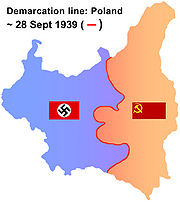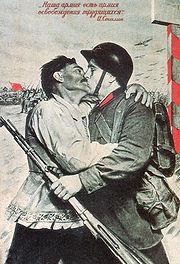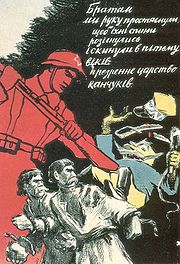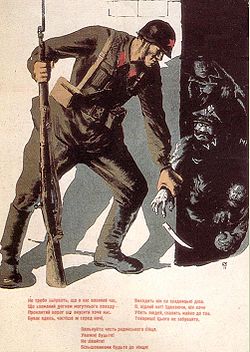
Elections to the People's Assemblies of Western Ukraine and Western Belarus
Encyclopedia

Second Polish Republic
The Second Polish Republic, Second Commonwealth of Poland or interwar Poland refers to Poland between the two world wars; a period in Polish history in which Poland was restored as an independent state. Officially known as the Republic of Poland or the Commonwealth of Poland , the Polish state was...
. Following the secret protocol of the Molotov-Ribbentrop Pact
Molotov-Ribbentrop Pact
The Molotov–Ribbentrop Pact, named after the Soviet foreign minister Vyacheslav Molotov and the German foreign minister Joachim von Ribbentrop, was an agreement officially titled the Treaty of Non-Aggression between Germany and the Soviet Union and signed in Moscow in the late hours of 23 August 1939...
, eastern territories of Poland
Kresy
The Polish term Kresy refers to a land considered by Poles as historical eastern provinces of their country. Today, it makes western Ukraine, western Belarus, as well as eastern Lithuania, with such major cities, as Lviv, Vilnius, and Hrodna. This territory belonged to the Polish-Lithuanian...
were occupied by the Red Army
Red Army
The Workers' and Peasants' Red Army started out as the Soviet Union's revolutionary communist combat groups during the Russian Civil War of 1918-1922. It grew into the national army of the Soviet Union. By the 1930s the Red Army was among the largest armies in history.The "Red Army" name refers to...
in September 1939 (see: Soviet invasion of Poland
Soviet invasion of Poland
Soviet invasion of Poland can refer to:* the second phase of the Polish-Soviet War of 1920 when Soviet armies marched on Warsaw, Poland* Soviet invasion of Poland of 1939 when Soviet Union allied with Nazi Germany attacked Second Polish Republic...
). The elections took place in an atmosphere of state terror, they were rigged, and their result was to become the official legitimization of Soviet annexation of West Belarus
West Belarus
West Belarus is the name used in reference to the territory of modern Belarus which belonged to the Second Polish Republic between 1919 and 1939. The area of West Belarus was annexed into the Belarusian Soviet Socialist Republic following staged elections soon after the Nazi-Soviet Invasion of...
and Western Ukraine
Ukraine
Ukraine is a country in Eastern Europe. It has an area of 603,628 km², making it the second largest contiguous country on the European continent, after Russia...
. Consequently, both Assemblies voted for incorporation of both provinces into the Soviet Union.



Background
On September 17, 1939, the Red Army invaded eastern Poland, facing weak resistance of units of the Border Defence Corps, scattered along the border. The Soviets moved quickly westwards, towards the line of partition of Poland, established earlier, during Soviet - Nazi negotiations. After the invasion, the Second Polish Republic and Soviet Union found themselves de facto at war with each other, and Soviet authorities took advantage of the situation, to make permanent changes of the legal order of occupied territories. Their activities broke Article 43 of the 1907 Hague ConventionHague Conventions (1899 and 1907)
The Hague Conventions were two international treaties negotiated at international peace conferences at The Hague in the Netherlands: The First Hague Conference in 1899 and the Second Hague Conference in 1907...
, which states: "The authority of the legitimate power having in fact passed into the hands of the occupant, the latter shall take all the measures in his power to restore, and ensure, as far as possible, public order and safety, while respecting, unless absolutely prevented, the laws in force in the country".
As soon as the Soviets occupied Polish areas, they began organizing local governments and units of administrative division, whose borders roughly corresponded with the borders of interbellum voivodeship
Voivodeship
Voivodship is a term denoting the position of, or more commonly the area administered by, a voivod. Voivodeships have existed since medieval times in Poland, Romania, Hungary, Lithuania, Latvia, Russia and Serbia....
s. Temporary authorities were made of NKVD
NKVD
The People's Commissariat for Internal Affairs was the public and secret police organization of the Soviet Union that directly executed the rule of power of the Soviets, including political repression, during the era of Joseph Stalin....
agents, Red Army officers, local laborers, and left-wing intelligentsia
Intelligentsia
The intelligentsia is a social class of people engaged in complex, mental and creative labor directed to the development and dissemination of culture, encompassing intellectuals and social groups close to them...
. Their task was to organize the so-called workers guard in the municipal centers, and farmers committees, which were preparing land reform. Soon afterwards, these temporary authorities were replaced with Soviet-style administration and Communist Party of the Soviet Union
Communist Party of the Soviet Union
The Communist Party of the Soviet Union was the only legal, ruling political party in the Soviet Union and one of the largest communist organizations in the world...
committees. Also, NKVD apparatus took over military tasks.
After signing the German-Soviet Boundary and Friendship Treaty
German-Soviet Boundary and Friendship Treaty
The German–Soviet Treaty of Friendship, Cooperation and Demarcation was a treaty signed by Nazi Germany and the Soviet Union on September 28, 1939 after jointly invading Poland. It was signed by Joachim von Ribbentrop and Vyacheslav Molotov, the foreign ministers for Germany and the Soviet Union...
(28 September 1939), which established the mutual border along the Bug River
Bug River
The Bug River is a left tributary of the Narew river flows from central Ukraine to the west, passing along the Ukraine-Polish and Polish-Belarusian border and into Poland, where it empties into the Narew river near Serock. The part between the lake and the Vistula River is sometimes referred to as...
, the Politburo of the Central Committee of the Communist Party of the Soviet Union
Politburo of the Central Committee of the Communist Party of the Soviet Union
The Politburo , known as the Presidium from 1952 to 1966, functioned as the central policymaking and governing body of the Communist Party of the Soviet Union.-Duties and responsibilities:The...
decided on October 1, 1939, that People's Assemblies of Western Ukraine
Ukraine
Ukraine is a country in Eastern Europe. It has an area of 603,628 km², making it the second largest contiguous country on the European continent, after Russia...
and West Belarus
West Belarus
West Belarus is the name used in reference to the territory of modern Belarus which belonged to the Second Polish Republic between 1919 and 1939. The area of West Belarus was annexed into the Belarusian Soviet Socialist Republic following staged elections soon after the Nazi-Soviet Invasion of...
should be called in Lviv
Lviv
Lviv is a city in western Ukraine. The city is regarded as one of the main cultural centres of today's Ukraine and historically has also been a major Polish and Jewish cultural center, as Poles and Jews were the two main ethnicities of the city until the outbreak of World War II and the following...
(for Western Ukraine), and Belastok (for West Belarus). The task of these bodies was to urge Moscow to incorporate the land into the Soviet Union. Furthermore, a People's Assembly of Poland had been planned, for the areas around Lublin
Lublin
Lublin is the ninth largest city in Poland. It is the capital of Lublin Voivodeship with a population of 350,392 . Lublin is also the largest Polish city east of the Vistula river...
, Siedlce
Siedlce
Siedlce ) is a city in eastern Poland with 77,392 inhabitants . Situated in the Masovian Voivodeship , previously the city was the capital of a separate Siedlce Voivodeship ....
, and Łomża, which were to have been annexed by the Soviets. However, after some changes in the Nazi - Soviet Pact (see German–Soviet Treaty of Friendship, Cooperation and Demarcation), those areas were occupied by Nazi Germany.
The election
The electoral campaign began on October 7, 1939, and from the beginning, it was supervised by the NKVD. The campaign itself took place in an atmosphere of state terror, with mass arrests, and uniformed NKVD agents present at polling stations. All candidates had been designated by the party's local peasants and workers' committees, and it was impossible to vote for anybody else. Banners and posters were seen everywhere, people were gathered to listen to propaganda slogans, and frequently, citizens were told that if they did not participate, they would be fired, arrested, and event sent to SiberiaSiberia
Siberia is an extensive region constituting almost all of Northern Asia. Comprising the central and eastern portion of the Russian Federation, it was part of the Soviet Union from its beginning, as its predecessor states, the Tsardom of Russia and the Russian Empire, conquered it during the 16th...
. Electoral meetings were very short - participants were asked who was against a candidate presented, frightened people did not raise their hands, and then the meeting was closed. On October 11, in article published in Pravda
Pravda
Pravda was a leading newspaper of the Soviet Union and an official organ of the Central Committee of the Communist Party between 1912 and 1991....
, Soviet propaganda pointed out the issues to be solved by the Western Ukraine's Assembly. These were: establishment of Soviet authority, unification of Western Ukraine with Soviet Ukraine, confiscation of estates, and nationalization of banks and industrial properties. There were instances when local Polish Communists, especially in Western Belarus, tried to designate their own candidates, but these attempts were immediately dismissed by the party officials.
The Polish historian Rafal Wnuk
Rafal Wnuk
Rafał Wnuk is a Polish historian, editor of several historical periodicals, employee of the Institute of History of the Polish Academy of Sciences and of the Polish Institute of National Remembrance...
, author of the book "During the First Soviet", described the election in the city of Lviv. According to him, on the day of the election, the city was full of propaganda posters, and at the polling stations, the inhabitants were able to purchase food and alcohol products, otherwise not available on the market. In some cases, people were brought by force. As Bronislawa Stachowicz from Lviv recalled: "I was forced to vote, taken from home only in slippers and bathrobe. I was escorted by two miliatiamen and NKVD agent, who did not let me to put on my coat. My mother, brother, and sister were also forced to vote". At all voting stations, there were uniformed militia or soldiers, and names were checked on a list. Voting was monitored to such a degree that in some places people were given envelopes which had been already sealed, and told to drop them in the box. Both the campaign and the election were presented as a "great holiday of the freed people". A Polish-language newspaper "Wolna Łomża" ("Free Łomża") wrote on October 22 that "suppressed by the Polish masters masses of Western Belarus had been waiting for this day [October 22] for almost twenty years". Another newspaper, "Nowe Zycie" ("New Life") wrote: "Never before has the nation enjoyed so much freedom as now, given by the Red Army".
The results of the election show the efficiency of the Stalinist state. According to the official data, in Western Ukraine, 93% voters took part in it, and in Western Belarus - 96%. Party candidates garnered more than 90% of the popular vote. However, in some districts (11 in Ukraine, and 2 in Belarus), the candidates were so unpopular, that they got less than half of the votes, and it was necessary to organize a second election. It must also be noted, that among those eligible to vote, were soldiers of the Red Army, who had invaded these provinces just five weeks before. Polish historians noted some cases of civil disobedience, which took place despite widespread terror. In Białystok, people would put in cards with slogans such as "Long live Poland, Białystok is not Belarus". In Hrodna
Hrodna
Grodno or Hrodna , is a city in Belarus. It is located on the Neman River , close to the borders of Poland and Lithuania . It has 327,540 inhabitants...
, slogans on the walls were painted, which said "Down with the Bolsheviks, long live Poland", and in Pinsk
Pinsk
Pinsk , a town in Belarus, in the Polesia region, traversed by the river Pripyat, at the confluence of the Strumen and Pina rivers. The region was known as the Marsh of Pinsk. It is a fertile agricultural center. It lies south-west of Minsk. The population is about 130,000...
, high school students handed leaflets stating: "Long live Poland, down with Communists".
People's Assemblies of Western Ukraine and Western Belarus
Deputies, elected in the rigged election, formed two legislative bodies - the People's Assembly of Western Ukraine, and the People's Assembly of Western Belarus. Meetings of these bodies took place respectively on 26–28 October 1939 in Lviv, and 28–30 October in Białystok. The Lviv meeting was opened by Ukrainian philology professor Kyryl StudynskyKyryl Studynsky
Kyryl Studynsky , was a western Ukrainian political and cultural figure from the late-19th to the mid-20th century. One of the principal figures within the Christian Social Movement in Ukraine, in 1939 Studynsky became head of the People's Assembly of Western Ukraine following the Soviet...
, and the Białystok meeting - by Belarusian peasant Stepan Strug. Out of 926 members of the People's Assembly of Western Belarus, there were 621 Belarusians, 127 Poles, 72 Jews, 43 Russians, 53 Ukrainians, and 10 from other nationalities. The Western Ukraine's People's Assembly had 1,482 members, out of which Poles made only 3%. Both bodies supported the establishment of Soviet rule over the occupied territories, and issued official requests to the Supreme Soviet
Supreme Soviet
The Supreme Soviet of the Soviet Union was the Supreme Soviet in the Soviet Union and the only one with the power to pass constitutional amendments...
, asking it for permission to join the already existing Byelorussian Soviet Socialist Republic and Ukrainian Soviet Socialist Republic. Also, all real estate of landowners, churches and state officials, was confiscated without compensation (including buildings and animals). Banks and larger factories were nationalized, and September 17 was established as an official holiday. Meetings of both Assemblies were based on criticism of interbellum Poland, describing "exterminational policies of White Polish occupiers, bloodsuckers and landowners", who suppressed "Ukrainian and Belarusian masses". People's Assembly of Western Ukraine wrote an official letter, which was sent to the Belarusian Assembly. Among others, it said: "We were brothers in captivity and struggle against Polish masters. Now we have become brothers in freedom and happines. Great Red Army, fulfilling the wishes of the mighty Soviet nations, has come here and for centuries freed us, Western Ukrainians and Western Belarusians, from suppression of Polish landowners and capitalists"
On November 1, the Supreme Soviet approved annexation of Western Ukraine, and on the next day, of Western Belarus. On November 14, the Supreme Soviet of Byelorussian Soviet Socialist Republic in Minsk
Minsk
- Ecological situation :The ecological situation is monitored by Republican Center of Radioactive and Environmental Control .During 2003–2008 the overall weight of contaminants increased from 186,000 to 247,400 tons. The change of gas as industrial fuel to mazut for financial reasons has worsened...
officially annexed former territories of northeastern Poland, without the area of Wilno, which had been seized by Lithuania. On November 15, the Supreme Soviet of Ukrainian Soviet Socialist Republic in Kiev
Kiev
Kiev or Kyiv is the capital and the largest city of Ukraine, located in the north central part of the country on the Dnieper River. The population as of the 2001 census was 2,611,300. However, higher numbers have been cited in the press....
, annexed former southeastern Poland. On November 29, the Supreme Soviet issued a decree upon which all inhabitants of Poland living in Western Ukraine and Western Belarus became citizens of the Soviet Union. This decision had a far-reaching consequences, because now, the NKVD apparatus had legal reasons to arrest members of prewar political parties of Poland, accusing them of anti-Soviet activity. Furthermore, the Supreme Soviet's decree resulted in massive draft into the Red Army. Polish historian Rafal Wnuk
Rafal Wnuk
Rafał Wnuk is a Polish historian, editor of several historical periodicals, employee of the Institute of History of the Polish Academy of Sciences and of the Polish Institute of National Remembrance...
estimates that 210 000 inhabitants of former eastern Poland, born in 1917, 1918, and 1919, ended up in the Red Army. After official annexation of Western Ukraine and Western Belarus, both Assemblies were dissolved.
See also
- Soviet annexation of Western Ukraine, 1939–1940Soviet annexation of Western Ukraine, 1939–1940On the basis of a secret clause of the Molotov–Ribbentrop Pact between Nazi Germany and the Soviet Union , the Soviet Union invaded Poland on September 17, 1939, capturing the eastern regions of Poland , with Galicia and Volhynia, facing little Polish opposition and occupying the principal city of...
- Occupation of the Baltic states
- German–Soviet military parade in Brest-LitovskGerman–Soviet military parade in Brest-LitovskGerman–Soviet military parade in Brest-Litovsk refers to an official ceremony held by the troops of Nazi Germany and the Soviet Union on September 22, 1939 during the invasion of Poland in the city of Brest-Litovsk , which marked the withdrawal of German troops to the previously agreed demarcation...
- Polish territories annexed by Nazi Germany
- Polish territories annexed by the Soviet Union
- Soviet repressions of Polish citizens (1939–1946)
- Occupation of Poland (1939–1945)
- Territories of Poland annexed by the Soviet Union

